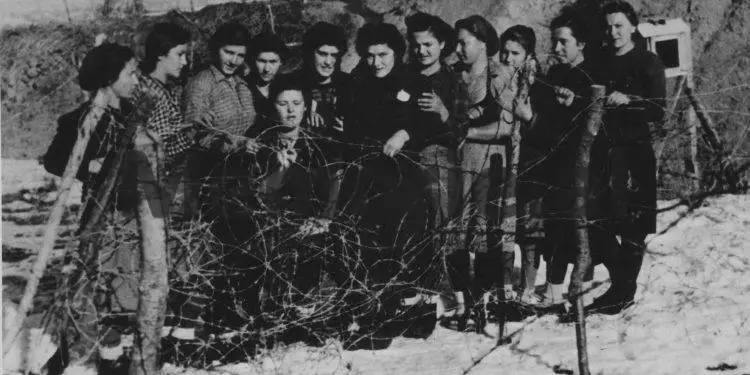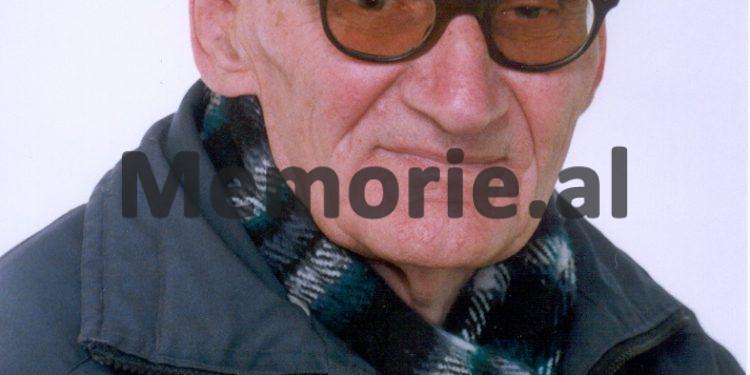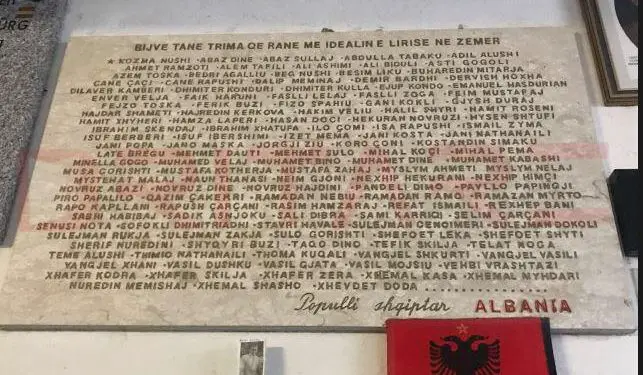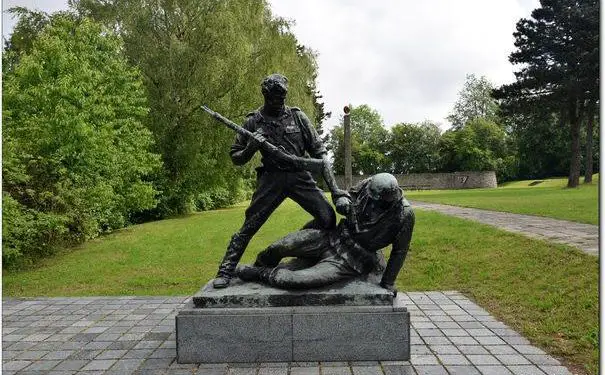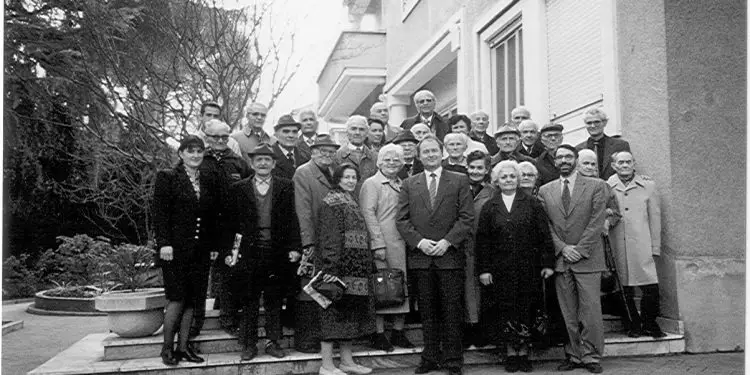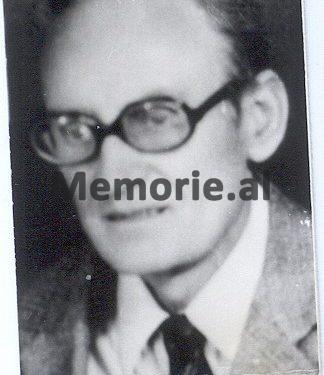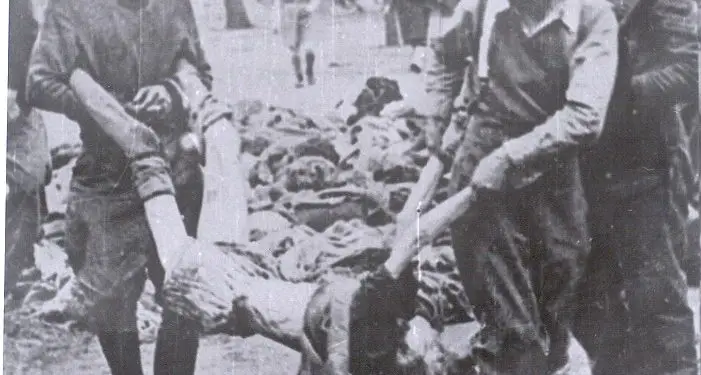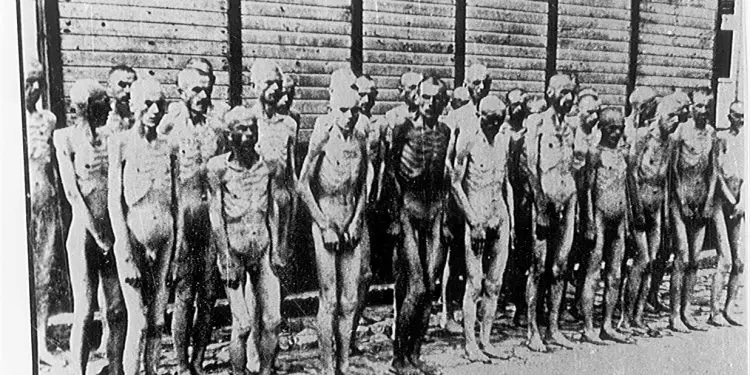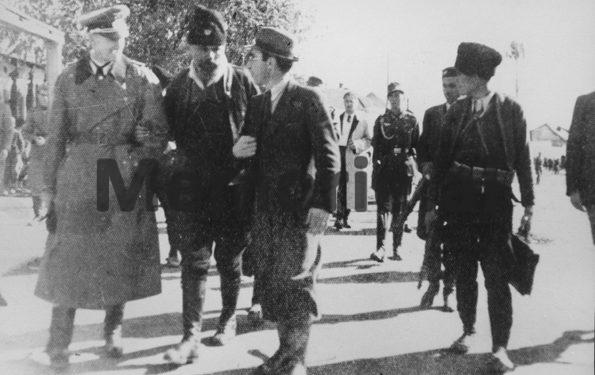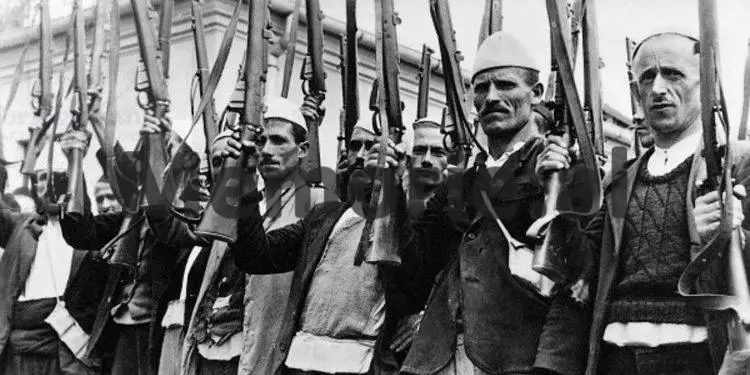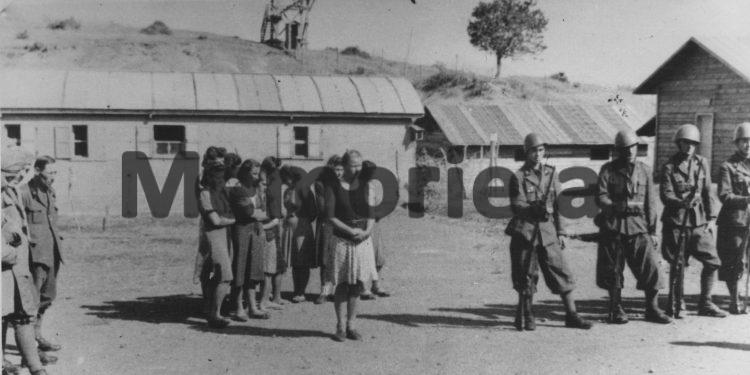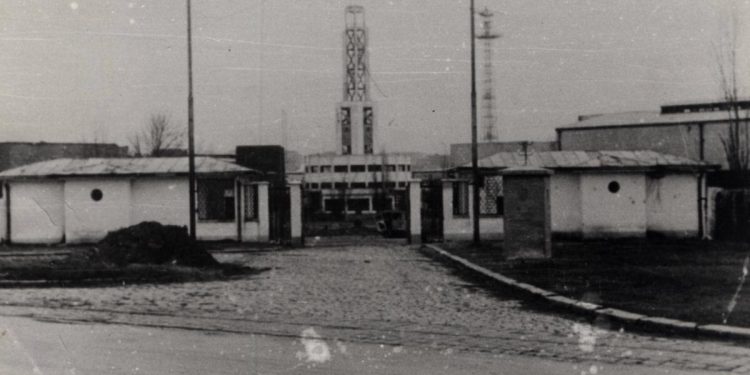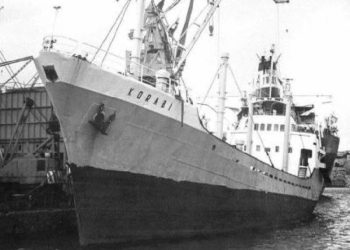Dashnor Kaloçi
Memorie. al In commemoration of May 9, the day of victory over fascism, publishes the unknown story of Albanians who during the German occupation of the country, were arrested and interned in the concentration camps they had set up in Yugoslavia at the time, such as in Pristina, Zemun, and Banica near Belgrade, where about 500 Albanians were serving their sentences at the time. The rare testimonies of Beqir Ramazan Xhepa, one of the few Albanians who survived the Nazi extermination camps, which tells about the initial journey of Albanian prisoners with military trucks on the route: Tirana, Elbasan, Struga, Bitola and from there by train to the Zemun camp on the outskirts of Belgrade. How were Albanian, Yugoslav and Greek prisoners treated in that camp, from the inhumane living conditions, food, and epidemics with contagious diseases where 130 Albanians died, to the tortures inflicted on them and the names of those Albanians who collaborated with the Germans in harm to their compatriots ?!
Mr. Beqir, do you have any idea that how many Albanian suffered in Nazi concentration camps during your arrest until your liberation from Anglo-American allies from Mauthausen?
“In the Nazi extermination camps that the Nazis had opened in almost every European country, unfortunately there were also some Albanians who worked closely with the Gestapo and who spied on or mistreated their compatriots. Among them we can mention Hilmi H. and Thanas B. from Vlora, or their two patriots Dr. Vasili and Dr. Lluka, who treated the Albanians who were imprisoned in those internment camps very badly. During visits to their compatriots, Dr. Vasili and Dr. Lluka stood two meters away from the convicts and lifted their shirt with a leash because they were afraid of getting a contagious disease, such as typhoid fever or dysentery. Or sometimes they were expelled and not visited at all. Both were Gestapo collaborators and returned home in August 1944. While others were sent to exterminate them in Mauthausen. Dr. At the end of the war, Vasili fled to Italy. This is what Beqir Ramazan Xhepa, who was one of the few survivors who managed to escape from those terrible camps, testified, among other things. Although he had been a courier for Qemal Stafa and their home in the center of Tirana was one of the most powerful bases where some of the main leaders of the Albanian Communist Party were housed, Beqir Xhepa was imprisoned four times by the communist regime of Enver Hoxha, and along with him, other family members, such as his father, uncle, brother, etc., where some died under torture or were permanently maimed by the inhuman treatment of the investigator. While with all this we are acquainted in a long interview of Mr. Xhepa, where he gave his testimonies regarding the involvement of Enver Hoxha in the murder of Qemal Stafa and then the sentencing of all his friends, in this article, he testifies to one of the most painful and tragic stories of Albanians who suffered. in Nazi concentration camps, such as Zemuni, Banica, Mauthausen, Gusen, Ebensee, Melk, etc., where he personally suffered after being arrested by German forces by sending a letter to the Peza Squad in 1943.
From the former internees in the Nazi concentration camps, both in Yugoslavia where Banica and Zemuni stood out, and in Austria, where Mauthausen, Gusen, Ebensee, Melk, etc. stood out, there have been dozens of Albanians, numbering 517. people. Of all these internees in these camps, I myself have managed to gather the names of 132 people, of whom only 24 returned alive to Albania.
How did the Albanian prisoners get to those remote places where the Nazis had set up concentration camps?
The first gateway for Albanian prisoners to be arrested by the Germans and interned in their camps across Europe was the Pristina camp, and later the Zemun and Banica camps in Yugoslavia. Among the Albanian prisoners who have suffered in those camps have been my friends: Avdulla Krutani, Leonidha Heba, Hamdi Tafmizi, Mihal Marto, Andon Leonidha, Mihal Konomi, etc. At the Zemun concentration camp in Yugoslavia, Albanian prisoners stayed in seven groups, three of which were from Vlora, one from Elbasan, one from Kavaja, one from Tirana, and one from Durres. The first group from Vlora had gone there since September 1943, and after two weeks another group from Vlora went there again. In December 1943, groups from Tirana, Elbasan and Kavaja also went there, while the last was the group from Durrës.
How many prisoners did these groups consist of and how did the trip to those camps take place?
Each group had an average of 80 to 100 people. So in total, about 500 and some Albanians gathered in Zemun. The departure route to Zemun was from Tirana to Elbasan, then to Struga and Bitola. All this road was made by cars (military trucks) where each car had 6 to 8 Gestapo SS soldiers with automatic, and who were ready to pull the finger. While the prisoners were tied two by two. From the Monastery to Zemun, the journey was by train. The wagons were for goods or rather for animals, but had been returned to the prisoners and they had a small window secured with bars. Each wagon usually carried 40 prisoners, and the journey to Zemun took six days. Prisoners lost their senses from this torturous and tedious journey. Who could have a quilt or blanket from home and could sleep piece by piece, but all that sleep he didn’t get from the cold to get into the marrow, while most of us had nothing.
During that trip, how were the prisoners treated?
During the trip to Zemun the food for each person for the 6 days was 500 gr. bread and 500 gr. vegetables. Among other things, the prisoners were dried by the cold because they had no blankets or blankets. There were no places to sit in the carriages, so the prisoners stood, or took turns to sit down 10 by 10. During that exhausting journey, we dried our lips for a drop of water. So in this exhausted state, without eating and drinking, tired and sleepless, constantly under the threat and blows of rifle butts, we traveled 6 days and nights. At midnight we arrived in Zemun, and from the train station to the camp you had to walk for at least an hour on foot. After an hour, the prisoners arrived at the gate of the camp, where it was written “Whoever enters, does not come out alive, but death awaits him”.
How do you remember the Zemun camp?
The Zemun camp was located on the outskirts of Belgrade, 4 km. far to its north, beyond the Sava River. In fact, part of the camp, which was bordered by the river, was surrounded by barbed wire. The camp was on a territory of 2 km. square, where every 100 meters there was a bunker, and in it stood the German guards with heavy machine guns. There were a total of 40 such bunkers and as many guards with machine guns. Near the camp was the Sava River bridge that connected Belgrade with Zemun. It was protected by several anti-aircraft cannons placed at the entrance and exit of the bridge. The camp consisted of 6 large barracks where it was estimated that in each silo, there were 3,000 prisoners, i.e. in total the camp’s capacity was about 20,000 prisoners. Two of these barracks were filled, one with male prisoners and the other with females. Among the women were two Albanian women from Elbasan, mother and daughter, Katina and Leni Dilo. The barracks where the men were housed exceeded their capacity because there were over 5,000 prisoners.
How many German troops and guards did that camp provide?
A total of 500 SS and Gestapo troops were stationed to guard and protect the camp. The Zemun camp was one of the largest and most horrific that the Nazis had set up in the Balkans, and even out of danger, at many points it surpassed the so-called camps or classified “first, second or second” camps. third ”, except that this camp lacked a gas chamber and a crematorium.
How much food was given to the prisoners in that camp?
The food was 200 gr. bread a day and half a liter of potato skin soup, as potatoes are eaten by SS soldiers, as well as fat-free wheat juice. Sleeping was horrible in the boxless wooden box without cover and cover, 100 people on each floor of the box. There were no facilities to perform personal needs, these were performed in buckets, emptied into large pits in the camp yard. Hygiene was in terrible condition. There was no water to clean, the dirt was great, the lice covered us and drowned the prisoners. All of this was accompanied by torture to send him to certain death.
From these miserable conditions in which you found yourself, were there any cases of disease or epidemics?
Diseases such as dysentery, typhoid fever, etc. spread there. Every day 30-40 prisoners died, or we can say an average of 2-3 Albanians a day. The dead prisoners were put in a large common pit, as there was no crematorium to burn the corpses. A total of about 130 Albanians died in this camp, this was certainly the beginning, as the physique had not yet weakened much, because it was the first months of internment in a terrible camp such as that of Zemun. Those dying prisoners were put in common pits. One night they left in a large shabby newspaper to sleep and the next day they reunited with friends (other prisoners). But from the great cold we did not sleep, we spent the whole night sitting and breaking boxes to make fire for heating. These boxes were large three-story beds for sleeping inmates.
What about Serbs who collaborated with the Nazis in the Zemun camp?
Along with the German Nazis, there were also Serbs, such as the two well-known criminals of the camp, the Serbian Chetniks, called: Bane and Milorad, who hated Albanians very much and called them “Arnaut”.
What were they, and under what circumstances were they?
Both had been partisans, battalion commanders. They were captured by the Germans and betrayed, agreeing to cooperate with them. Hundreds of prisoners had died from beatings and torture. Like these, there were many others in the camp who had joined the SS and there were about 50 of them. Unfortunately, among them were Albanians who collaborated with the Nazis to the detriment of their compatriots.
Who were they?
Along with the two Serbs I mentioned above, there was also the Albanian captain named Thanas from Vlora, who was in charge of the “Albanian captain” and at that time was about 45-50 years old. There were other provocateurs and spies in this camp, who had come as prisoners, but their mission was certain.
How were they treated?
They did not live the life of a prisoner because they had other duties. One of them was the Albanian Hilmi from Vlora, who was Gestapo’s spy and direct collaborator and had direct links to the camp commander and Bana. He did not live with the prisoners, but had a separate and very comfortable room compared to the rest of the prisoners. There were all the things he needed, such as a sink, a toilet, a personal wardrobe, and so on. Hilmi came to the camp there in January 1944, and in March, after completing his mission and the tasks assigned to him by the Gestapo against the Albanians, he allegedly got the right to return to Albania, but before returning. , had to pass the three-week quarantine period.
For all the services he rendered to the Germans to the detriment of his countrymen, what did he gain?
Hilmi did not have any personal benefit for the service he had rendered to Gestapo and the camp commander, where in cooperation with the Serb, Bane, for the valuable things they had forcibly abducted Albanians, he went and denounced to the camp SS commander, (with whom Bania had cooperated) exactly with the commander for whom Hilmi denounced him, and Bania had shared these precious things precisely with the commander.
What happened after this denunciation?
To get himself washed, the commander gathered all the Albanians and asked them about such a thing, whether Bania had really taken anything from them or not? According to Kozma Nushi’s instructions, knowing that these were taken from Bania and shared with the camp commander, so they would have no benefit if they claimed and said that it is true that Bania has taken our precious things, we were forced to deny Hilmi’s statements and denunciations and told him that they were not true.
What did they say to Hilmi after that?
The camp commander then ordered all Albanians to give Hilmi five dajaks. After these beatings, Hilmi could not resist and after 24 hours in agony, he died. Thus ended Hilmi, who had served the Germans with great zeal.
But apart from Hilmi and Thanas, were there any other Albanians cooperating with the Germans?
There were two other doctors in the Vlora group, Dr. Vasili and Dr. Lluka, who behaved very badly with the Albanians imprisoned in that camp.
Why ?!
Because during the visits they made to their compatriots, Dr. Vasili and Dr. They stood two meters away from them and lifted their shirts with a perch to visit, for fear of contracting a contagious disease such as typhoid fever, dysentery, etc. Or they were expelled for insulting them and not visiting them at all. Both were Gestapo collaborators.
How did they end up?
In August 1944, they returned home, while others were sent to exterminate them in Mauthausen. Dr. Vasili, after the war, fled from Albania to Italy. But in addition to these, there were many other Albanians in that camp who were inmates and helped them.
Who were they?
One of them was Dr. Pavlo from Berat, a very good man, very positive. With these humane qualities he had, he helped all the prisoners in general. During his visits, he provided medical assistance and other instructions to the prisoners, showing them how to act in self-defense against criminals. This behavior was not only against his Albanian compatriots but also against other foreign citizens, such as Bulgarians, Yugoslavs, Greeks, etc. While with the Durrës group, there was also Dr. Mihal Konomi and this very good and humane man, who together with Dr. Pavlo Doko, served with all his might to the prisoners.
What were the rules in that camp?
As in all German camps, there were special rules. The German commander of the camp, along with his suite and two Serbian criminals, after introducing the prisoners to the camp regulations and dividing them into Muslims on one side and Christians on the other, ironically, told the prisoners that in the regulation of camp, allegedly included games, entertainment, music, movies, etc.
What games and entertainments were we talking about ?!
These amusements and games were nothing but beatings that would make us prisoners, two Serbian criminals, Bania and Milorad. As for the music, they considered the calls of the prisoners when they were beaten or died in their hands by the beatings, and according to the regulation, the one who entered this camp for the first time, you will definitely be beaten. For Muslims, the “ration” was 50 beats, while for Christians, 20 beats. Then, beaten like this, he took us into the hands of the “Albanian captives”, and in a row sent us to the building (barracks, silo or barracks), another, where all the Yugoslav, Greek and Albanian prisoners were, because in Zemun only three nationalities he had.
How many prisoners were in that camp?
In total, there were 6,000 prisoners in the camp, mostly Yugoslavs, 517 Albanians, and 400 Greeks. The Zemun camp was set up by the Germans in 1941 with the specific purpose of imprisoning all those prisoners who were captured in the context of the suppression of the National Liberation Movements of the Balkan peoples that were coming and increasing, especially in Yugoslavia, Greece, and Albania. .
How was the internal organization of this camp?
Prisoners did not work in the absence of a work facility, but to get food at lunch, you had to take turns outside in the yard, in the rain, snow, frost, storm, and had to stay there for an hour until it was your turn. take broth juice.
Were there Albanians who could not stand and violated the rules of food?
There were those who entered twice in a row because they were starving, thus taking two shoulder rations, but this was considered a serious violation if understood and played with life.
Was there anyone who understood?
So it was with Hamdi Tahmizi, who entered the queue twice to get the soup with potato skins, but was spotted and caught by Milorad and beaten so hard with wood and kicked by him that he broke his right arm elbow… Even today, even though so many years have passed, he is a war invalid.
What about other cases of this nature with Albanians?
This is what happened to Abdulla Krutani, who was severely beaten for such an attempt, etc. This of course only happened to us Albanians. While this was not the case with the Yugoslavs, they did not feel so hungry because once a week or every two weeks, they received food packages from their families. So for them the issue of hunger or cold was not a problem at all. Torture, beatings, epidemics, and contagious diseases were problems for them.
Did the Yugoslavs help you with food and how did the Albanians go with the Yugoslavs and other nationalities who were in that camp?
The camp lacked international solidarity on the part of the Yugoslavs. Not only did they not help the Albanians and the Greeks with food, but on the other hand, they called us Albanians with contempt, “Arnauts”! This prisoner who treated us like that were Serbs and Croats.
Who were the other Albanians who suffered with you in that camp, was there any other well-known name?
The last group of Albanians to come to the Zemun camp in January 1944 was in Durrës. This group consisted of many intellectuals, as they had been educated and had various political responsibilities and functions in the Party. Because in this group was the whole Communist District of Durrës, headed by Kozma Nushi (Brother of Gogo Nushi, member of the Political Bureau of the Central Committee of the ALP until 1969 who died), former political secretary of the Regional Committee of the Communist Party for Durrës. Along with Kozmanë, there were other well-known names such as Enver Velja, Mihal Marto, Telat Noga, etc. With the arrival of this group, all the other Albanians seemed to come to life. Kozma Nushi, Enver Velja, etc., tried to keep the other Albanian prisoners alive and brave, which was very necessary considering the situation and the place where we were. Since most of us were there, we considered ourselves dead and had lost all hope that one day we would come out alive from there and return to our families who were waiting for us, weeping every day.
How many Albanians died in the Zemun camp?
In the Zemun camp, in a relatively short period of time, about 34 months, about 120 or 130 Albanians died from torture and epidemics.
What happened to the camp of Zamun, what was its end?
On April 17, 1944, British bombers began bombing Belgrade as early as 8 a.m., making every effort to bomb the bridge over the Sava River that connected Belgrade to Zemun. Zemun was known to be the largest military airfield in Yugoslavia. Although the bridge was protected by two anti-aircraft guns, the first bomb fell on the men’s prison building. A total of 17 bombs exploded throughout the camp, destroying three large barracks where prisoners slept and killing about 400, leaving more than 700 injured, most of them. Yugoslavs.
Were there Albanians among those killed that day by the bombings?
Among those killed were two Albanians, Dr. Pavllo Doko and a priest from Mallakastra. From the bombings, Belgrade for two days and two nights all lit up by the flames of the bombs and so did Zemun who was on the field. These British airstrikes are known to be one of the most serious bombings in Belgrade during World War II. Inside the city of Belgrade, thousands of innocent civilians were killed or injured.
What happened to you prisoners after the destruction of the camp?
After the bombings, unable to keep the prisoners in the Zemun camp, as they were all destroyed by the bombs, the prisoners were transferred to the Banica prison, located on the outskirts of Belgrade, while another part of the Yugoslav prisoners was transferred. through German internment camps.
How many Albanians were there in Banica prison?
There were about 382 Albanians in Banica prison, of which 512 were in Zemun. So about 130 prisoners had died from torture in Zemun.
Compared to Zemun, what were the conditions like there in Banica?
Banica Prison was a very old and well-secured prison. It had a large three-story building, with small windows well secured with bars, had dungeons and basements where the “most dangerous” prisoners were kept locked up, where they were tortured in the most inhumane way. That prison was located on a territory of 2 km. square and was surrounded by high walls, above the walls were placed wires with electrified thorns. In every corner of the wall, there was a tower, i.e. from four towers that controlled the entire interior and exterior of the prison.
How did the arrival of Albanian prisoners in that camp come about, did you get any help from prisoners of other nationalities, given the fact that the Communists were internationalists?
Seeing the plight of the young prisoners who came from Zemun, who were hungry, ill-treated and tortured, bone and skin wasted and completely defiled, the old prisoners of Banica prison, headed by the Revolutionary Committee that had created the Yugoslavs in this prison, who on the first day created and organized food aid for Albanians and Greeks. They did this by collecting all the rations of their bread that day as well as some other food that had come to them from their families.
Did this go on, or just the first few days you went?
This continued and later became a daily and regular aid, which, as I said, was organized by the Revolutionary Committee set up by the Yugoslavs. This was very positive, both materially and morally, which left me to realize that even in those difficult conditions, the prisoners found and helped each other, so there was hope. But despite all this, physical torture and spiritual torture, epidemics and contagious diseases, such as typhoid fever and dysentery, wreaked havoc, taking the lives of hundreds and hundreds of people a day from the prisoners who were there./Memorie.al
Follows tomorrow




